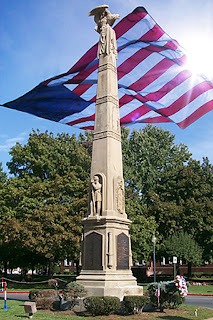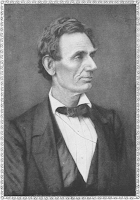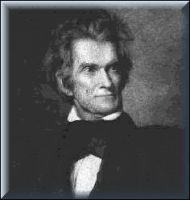On holidays like Memorial Day, the Fourth of July, and Veterans’ Day, we often give lip service only to what these days represent. It’s easy to forget the sacrifices of those in American history, which enable us to enjoy a family cookout with no thought of those service men and women who have committed themselves to protect and defend our privileges, our rights, our freedoms to do so.
 |
| Glens Falls Civil War Monument |
Every now and then, something jolts us out of our bland (and sometimes blind) acceptance of the status quo, and makes us think more deeply on the meanings of these holidays. As we recognize Memorial Day this week, I am mindful of one such epiphany.
In 1999, my husband Phillip, who gives a professional, first-person portrayal of President Abraham Lincoln, was asked to participate in the rededication of a Civil War monument in Glens Falls, NY. The monument (made from a Canadian sandstone - an unfortunate selection for this environment) had suffered deterioration from acid rain and wind erosion since 1868 when it was completed, but it had now been restored and stabilized, and a new bronze plaque had been fixed to it, naming a number of the town’s soldiers not in the original roster.
The rededication ceremony, part of a weekend of historical activities, featured a Civil War era brass band, a color guard, Civil War reenactors, and speeches by local and regional leaders and historians, culminating with the unveiling of the renewed monument and a detailed explanation of its improvements. The National Guard fired 13 rounds from two modern howitzers, to honor the thirteen soldiers whose names were added to the monument.
Phillip and I have been active reenactors since before the Bicentennial, in both American Revolution and Civil War living history events. As a result, we are perhaps more aware than the general public of the reasons, principles, or commitments of the civilian soldiers or volunteer soldiers of those days. But no matter how we may strive to reproduce even a semblance of the lives of those we portray, most of us have not “been there, done that.” The awful realities of war remain comfortably, distantly academic to us civilians.
As a reenactor, I have become accustomed to gunfire, and rarely even blink. The howitzers, however, placed at the far end of a parking lot and pointed away from the gathering, were louder than anything even a reenactor hears. As modern guns, their report - even firing blanks - is much sharper and louder than that of 18th or 19th Century artillery. When these guns spoke, everyone jumped. Many in the audience yelped in surprise, laughing nervously afterward, and car alarms nearby began to blare.
As I sat on the dais, my back to the howitzers, I was surprised at how intensely the sound of these big guns affected the audience. As I thought of it, I realized that these people were startled because they hear such things so rarely, if at all. We Americans do not, as a rule, hear gunfire often; most of us have never heard the thunder of artillery in person.
 |
| Modern Army howitzer and gun crew |
What a privilege that we do not! What a tribute to the work of our military over the past 200+ years - and today - protecting us! What peace of place and of mind they provide us! It never occurs to us to think about how our daily routines are uninterrupted, ungoverned by the drone of bombers overhead delivering their payload, by the rattle of machine guns tearing ribbons of holes into everything. Despite superficial disorder and minor disasters, our daily lives are, for the most part, organized and civilized. On most days, most of us rise, go to work or school, engage in social or civic functions in the evening, turn out the lights at night with our families around us, intact, and sleep undisturbed. We plan our futures.
That the sound of military might is alien to our ears is a luxury. How many millions elsewhere in the world do not enjoy this kind of peace? In Libya? In Israel or Syria? In Central Asia? In Yemen or Serbia? In Korea or Viet Nam? How many have become deaf to the chronic battle around them every day, blind to the damage to every household, every community, dumb to the expression of horror at the unrelenting destruction - because to acknowledge it every moment leads to insanity? How many have never known anything else?
On this Memorial Day, let us take a few moments to reflect on the miracle that is the United States of America. Think on this: how many other nations have a military force governed and guided by principles within a constitution like ours, a remarkable document unlike anything in the world before or since? How many other nations have achieved such an equilibrium? We'll always have our warts, but our pearls far outnumber them.
I hope you will remember the sacrifices of those who have willingly put themselves in harm’s way - and who continue to do so - often giving that last full measure of devotion, in order that we civilians can engage in simple, social, domestic, and cultural activities like parades and cookouts, unassailed by a cacophony of angry artillery, a rain of fire, an endless chaos of violence.
My sincere and heartfelt thanks (woefully inadequate) go to all who serve and have served, for my benefit. God bless our service men and women, wherever they are. God bless the United States of America.
PHOTO SOURCES
Glens Falls Civil War Soldiers Monument - “Haversack Journal” Vol. 1, Issue 3 Fall 1999, 77th New York Regimental Balladeers http://ny77thballadeers.tripod.com/newsf99.html
howitzer - Courtesy of U.S. Army www.army.mil











